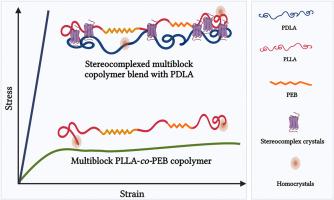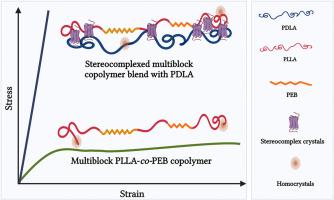Structure–property modulation in multiblock Poly(l-lactide-co-ethylene brassylate) copolymers and their stereocomplexed blends with Poly(d-lactide)
IF 4.5
2区 化学
Q2 POLYMER SCIENCE
引用次数: 0
Abstract
Copolymerization offers an effective alternative to physical blending for modulating polylactide (PLA) stereocomplexation and thermomechanical properties, primarily due to its ability to suppress microphase separation. In this study, we investigate the impact of ethylene brassylate (EB) incorporation in multiblock poly(l-lactide-co-ethylene brassylate) copolymers (PLEBs) across a range of LLA:EB ratios (100:0 to 60:40), as well as their stereocomplexed blends with poly(d-lactide) (SC-PLEBs). Comprehensive structural, thermal, and mechanical characterization was performed using nuclear magnetic resonance, gel permeation chromatography, differential scanning calorimetry, X-ray diffraction, thermal gravimetric analysis, tensile and dynamic mechanical analysis. We demonstrate that EB copolymerization significantly influences stereocomplex crystal formation and thermomechanical performance. Notably, the PLEB60/PDLA blend (SC60), containing about 50 % EB segments, achieved a stereocomplexation degree above 80 %, resulting in a 75 % increase in modulus compared to its corresponding copolymer (PLEB60), and an additional 500 MPa over the SC100 (PLLA/PDLA) blend allowing us to control the mechanical properties from ductile (copolymer) to rigid (stereocomplexed copolymer). Furthermore, SC60 exhibited a ∼10 K increase in glass transition temperature (Tg) relative to PLEB60, highlighting the structural reinforcement imparted by stereocomplexation. Our results underscore the importance of copolymerization in modulating stereocomplexation and thus the final material properties of polylactide enantiomeric blends for a wide range of applications, from soft to rigid.


多嵌段聚l -丙交酯-共聚物及其与聚d -丙交酯立体配位共混物的结构-性能调制
共聚为调节聚乳酸(PLA)立体络合和热机械性能提供了一种有效的替代物理共混,主要是由于其抑制微相分离的能力。在这项研究中,我们研究了在LLA:EB比例(100:0至60:40)范围内,在多嵌段聚(l -丙交酯-共乙烯- brassylate)共聚物(pleb)中掺入乙烯(EB)的影响,以及它们与聚(d -丙交酯)(sc - pleb)的立体络合物。采用核磁共振、凝胶渗透色谱、差示扫描量热法、x射线衍射、热重分析、拉伸和动态力学分析等方法进行了全面的结构、热、力学表征。我们证明了EB共聚对立体络合物晶体形成和热机械性能有显著影响。值得注意的是,含有约50% EB段的PLEB60/PDLA共混物(SC60)实现了80%以上的立体络合度,与相应的共聚物(PLEB60)相比,模量增加了75%,比SC100 (PLLA/PDLA)共混物增加了500 MPa,使我们能够控制从韧性(共聚物)到刚性(立体络合共聚物)的机械性能。此外,与PLEB60相比,SC60的玻璃化转变温度(Tg)增加了约10 K,突出了立体络合所带来的结构增强。我们的研究结果强调了共聚在调节立体络合中的重要性,从而使聚丙交酯对映体共混物的最终材料性能得到广泛的应用,从软到硬。
本文章由计算机程序翻译,如有差异,请以英文原文为准。
求助全文
约1分钟内获得全文
求助全文
来源期刊

Polymer
化学-高分子科学
CiteScore
7.90
自引率
8.70%
发文量
959
审稿时长
32 days
期刊介绍:
Polymer is an interdisciplinary journal dedicated to publishing innovative and significant advances in Polymer Physics, Chemistry and Technology. We welcome submissions on polymer hybrids, nanocomposites, characterisation and self-assembly. Polymer also publishes work on the technological application of polymers in energy and optoelectronics.
The main scope is covered but not limited to the following core areas:
Polymer Materials
Nanocomposites and hybrid nanomaterials
Polymer blends, films, fibres, networks and porous materials
Physical Characterization
Characterisation, modelling and simulation* of molecular and materials properties in bulk, solution, and thin films
Polymer Engineering
Advanced multiscale processing methods
Polymer Synthesis, Modification and Self-assembly
Including designer polymer architectures, mechanisms and kinetics, and supramolecular polymerization
Technological Applications
Polymers for energy generation and storage
Polymer membranes for separation technology
Polymers for opto- and microelectronics.
 求助内容:
求助内容: 应助结果提醒方式:
应助结果提醒方式:


